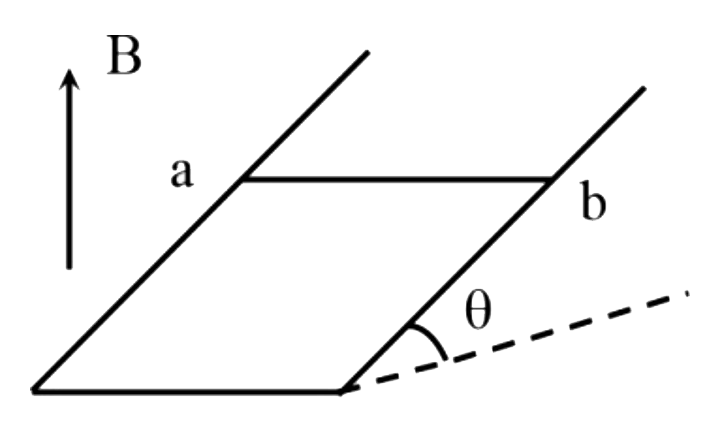A conducting wire XY of mass M and negligible resistance slides smothly on two parallel conducting wires as shown in figure. The closed circuit has a resistance R due to AC. AB and CD are perfect conductors. There is a magnetic field B=B(t)ˆk

Fig. shows a conducting wire XY of mass m and negligible resistance sliding smoothly over two parallel conducting wires AB and CD. The magneitic field applied is →B=B(t)ˆk
(i) At time t, suppose XY is at x = x (t)
Magnetic flux associated with area ACYX
ϕ=B(t).l.x.(t)
emf induced, e=dϕdt=−[dBdtlx(t)+B(t)l.v.(t)]
current induced , i=eR
Force on XY, F=Bil=B(eR)l or md2xdt=B(t).lR[−dBdtlx(t)−B(t).l.υ(t)]
∴ Acceleration of wire ,d2xdt2=−l2BmRdBdtx(t)=l2B2mR(dxdt)
(ii) When B is independent of time, it is constant w.r.t. time. Therefore, dBdt=0
From (ii), d2xdt2+l2B3mRdxdt=0 or dυdt+l2B2mRυ=0. ∴υ=Aexp(−l2B2tmR)
At t=0,υ=u0=A ∴υ(t)=u0exp(−l2b2tmR)
(iii) Now, I2R=B2l2υ2(t)R2×R using (iii) I2R=B2l2Ru20exp(−2l2B2tmR)
Power lost =∫t0I2Rdt=B2l2Ru20mR2l2B2[1−e−l2b2t/mR]=m2u2−m2υ2(t)
=decrease in KE of wire XY, which was to proved.
Topper's Solved these Questions
- ELECTROMAGNETIC INDUCTION & ALTERNATING CURRENTBOOK - PRADEEPCHAPTER - ELECTROMAGNETIC INDUCTION & ALTERNATING CURRENTEXERCISE - Very Short Answer Qusetions
1 Videos
- ELECTROMAGNETIC INDUCTION & ALTERNATING CURRENTBOOK - PRADEEPCHAPTER - ELECTROMAGNETIC INDUCTION & ALTERNATING CURRENTEXERCISE - Value Based Questions
2 Videos
- ELECTROMAGNETIC INDUCTION & ALTERNATING CURRENTBOOK - PRADEEPCHAPTER - ELECTROMAGNETIC INDUCTION & ALTERNATING CURRENTEXERCISE - NCERT Question
4 Videos
- DUAL NATURE OF RADIATION AND MATTERBOOK - PRADEEPCHAPTER - DUAL NATURE OF RADIATION AND MATTEREXERCISE - Exercise
191 Videos
- ELECTROMAGNETIC WAVESBOOK - PRADEEPCHAPTER - ELECTROMAGNETIC WAVESEXERCISE - II Focus multiple choice question
5 Videos
Similar Questions
A rod of mass m and resistance R slides smoothly over two parallel perfectly conducting wires kept sloping at an angle θ with respect to the horiaontal, Fig. The circuit is closed through a perfert conductor at the top. There is a constant magnetic field B along the vertical direction. If the rod is initially at rest, find the velocity of the rod as a function of time.
View SolutionThermal conductivity of the conductor shown in figure is K. Find thermal resistance between points a and b.
 .
.
View Solution
Knowledge Check
A conductor of mass m and length l is sliding smoothly an two vertical conducting rails AB and CD as shown in figure. The top ends of two conducting rails are joined by a capacitor of capacitance C. The conductor is relased from rest when it is very close to AC i.e., y=0. A uniform magnetic field B0 perpendicular to plane of figure existing. Neglect the resistance of rails and connecting wires. Take acceleration due to gravity to be g.

Based on above information answer the following questions:
Current in the circuit isAconstantBincreasing with timeCdecreasing with timeDFirst increase, then reaches a maximum value, and then starts decreasing to attain a constant value finallyA conductor of mass m and length l is sliding smoothly an two vertical conducting rails AB and CD as shown in figure. The top ends of two conducting rails are joined by a capacitor of capacitance C. The conductor is relased from rest when it is very close to AC i.e., y=0. A uniform magnetic field B0 perpendicular to plane of figure existing. Neglect the resistance of rails and connecting wires. Take acceleration due to gravity to be g.

Based on above information answer the following questions:
Mark the correct statement about the motion of conductorAIt is falling down with constant acceleration gBIt is falling down with constant acceleration but not equal to gCIt is falling down with increasing accelerationDIt is falling down with decreasing accelerationA conductor of mass m and length l is sliding smoothly an two vertical conducting rails AB and CD as shown in figure. The top ends of two conducting rails are joined by a capacitor of capacitance C. The conductor is relased from rest when it is very close to AC i.e., y=0. A uniform magnetic field B0 perpendicular to plane of figure existing. Neglect the resistance of rails and connecting wires. Take acceleration due to gravity to be g.

Based on above information answer the following questions:
Charge on the capacitor as a function of distance travelled y is given byACB0l√2mgym+CB20l2BCB0l√m+CB20l22mgyCCB0lemgym+CB20l2DCB0l√2mgym+CB20l2×emgym+CB20l2
A conducting rod AB of mass m, has negligible resistance and of length 0.5 m slides on a pair of parallel metalic rails, which are connected by a resistance R=10Ω and capacitance C=1μF as shown in the figure. A magnetic field B=1T is applied normal and into the plane of the circuit. At tim t=0 a force F=0.4N is applied on the rod AB. What will be the terminal speed acquired by rod?

View SolutionTwo conducting shells of radius a and b are connected by conducting wire as shown in figure. The capacity of system is :

View SolutionA wire ab of length l, mass m and resistance R slides on a smooth thick pair of metallic rails joined at the bottom as shown in fig. The plane of the rails makes an angle θ with the horizontal. A vertical magnetic field B exist in the region. If the wire slides on the rails at a constant speed v, then the value of B is -

View SolutionA horizontal wire is free to slide on the vertical rails of a conducting frame as shown in figure. The wire has a mass m and length l and the resistance of the circuit is R. If a uniform magnetic field B is directed perpendicular to the frame, the terminal speed of the wire as it falls under the force of gravity is

View SolutionA conducting wire is moving towards right in a magnetic field B. The direction of induced current in the wire is shown in the figure. The direction of magnetic field will be

View Solution
